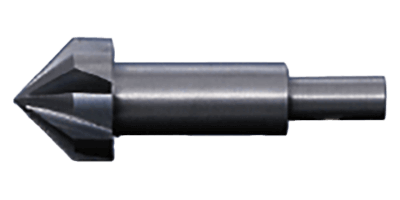What Is a Chamfering Cutter?

A chamfering cutter is a tool that is attached to the tip of an electric screwdriver or impact driver and rotated to deburr or reshape a screw hole.
Normally, when drilling holes in materials, corners (called faces) and burrs are formed. The role of a chamfering cutter is to remove these surfaces and burrs and smooth the surface.
They can also be used for processing the tip of the hole into a conical shape to prevent the screw head from sticking out when a screw is inserted into the drilled hole.
Uses of Chamfering Cutters
Chamfering cutters are usually attached to power tools. The tip of the chamfering cutter is in the form of a bit, so select a shape that matches the tool to which it is attached.
1. Chamfering and Deburring
Chamfering and deburring are almost the same. Both are used for cleaning up the edges of holes drilled with a drill or other tool. Usually, after drilling holes in metal or wood, the edges of the holes have burrs. In deburring, these burrs are removed using a chamfering cutter.
Chamfering is a process to remove the edge (surface) between the hole and the material surface, which is almost perpendicular to the hole after drilling. Chamfering is achieved by pushing the chamfering cutter further into the hole than deburring. These processes improve the appearance and feel of the threaded hole and prevent injuries due to spikes sticking into the hand.
2. Dish-Trimming
The countersunk process, also known as countersunk fir, is a process to create a conical space for the countersunk portion of a screw to sink into after the screw is fastened to the wood or metal. When screws are fastened to wood or metal that has not been countersunk, the plate portion protrudes from the surface of the object.
Not only does this look bad, but hands or clothes may get caught on the plate and cause injury. For this reason, the plate is removed to create a space where the plate part is hidden, so that the plate part does not show after screwing.
Another reason for countersunk processing is to prevent cracks in the material. If screws or screws are tightened with a high-tightening force tool, such as an impact driver without countersunk processing, cracks may appear in the material. This problem can be prevented by performing the countersunk process. The amount of chamfering is adjusted based on the size of the pan of the screw or screw to be used.
Principle of Chamfering Cutters
The tip of the chamfering cutter is conical, but it is not a perfect cone; instead, the cone is notched, and the notch is the cutting edge. This cutting edge makes it possible to shave wood in a conical shape.
Insert the chamfering cutter into the tip of the power tool, place it in the hole after drilling, and rotate it. The cutting edge on the tip of the chamfering cutter rotates at high-speed to remove the surfaces and burrs (shavings) generated during the drilling process and to form a conical hole.
How to Select a Chamfering Cutter
The following three points should be considered when selecting a chamfering cutter.
1. Blade Material
Although chamfering cutters can process a wide variety of materials, the material of the chamfering cutter blade must be changed according to the material. The most common blade materials are steel, HSS, and carbide tips. Usually, steel blades are used when the material is soft wood, etc. However, when the material is hard wood, resin, light metal, etc., it is better to use HSS or carbide-tipped blades.
2. Shape of the Shaft
Chamfering cutters are available in two types of shaft shapes: straight shaft and hexagonal shaft. Generally, chamfering cutters are often attached to electric screwdrivers, and in such cases, either shaft shape can be used. However, when used with an impact driver, only the hexagonal shaft can be attached.
3. Diameter
When using chamfering cutters, the required diameter varies depending on the type of processing. For chamfering and deburring, a slightly larger diameter (+5 to 10 mm) than the diameter of the hole to be processed is optimal.
On the other hand, if the purpose is to remove a countersunk hole, it is recommended to select a size that is the same as or slightly larger than the diameter of the screw head.